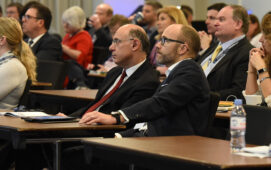MiFID II has introduced rigorous new requirements for timestamping and clock synchronisation, forcing firms to overhaul existing technology and implement new systems to comply. Accuracy is everything – but how successful has the industry been in meeting the tighter demands? In advance of A-Team’s webinar on timestamping and clock synchronisation tomorrow, we take a quick look at the key challenges of implementation.
Although the deadline for MiFID II has come and gone, and compliance has in the main been achieved, the challenges of the regulation’s requirements are ongoing – particularly in terms of the choice of clock and the consistency of reporting.
“One of the biggest challenges firms have faced is the transfer of time from its source (i.e., UTC or NIST) to the timestamping point, and the accuracy in acquiring and applying the timestamp to the event,” confirms Russell Lowes, senior FPGA engineer at Metamako.
Beyond that, the problem is not just capturing an accurate time source but distributing it throughout the organisation and, of course, monitoring it to ensure it does not drift and that traceability can be demonstrated to the regulator.
“I think firms have had more issues with their own internal infrastructure, getting the design right, implementing it, managing it, and monitoring it,” comments Hugh Cumberland of Cumberland Caine. “Then they have to prove to the regulator that they have actually taken all those steps – that’s the really tricky bit.”
According to Rory Chisholm, IT Project manager for the FinfraG Art 38 & Art 39 programs at UBS Investment Bank, traceability and consistency have indeed been a challenge. “MiFID II calls for the time signal to be traceable and provable to an approved source. The challenge is having a design that can be audited, and a time signal that we can successfully prove remains within the boundaries. Another challenge was finding a solution for monitoring the distribution of the time signal so that if one proponent of the overall architecture fails, the appropriate support analysts are alerted.”
These bugs are gradually being worked out – but are there more to come? “Firms have been successful in working to the letter of the regulations, but have taken risks in that implementation,” warns Lowes. “Different methods of time transfer and application pose different probabilities of being correct within any given bound. Thus depending on the implementation selected, firms may not be strictly 100% covered.”
Cumberland agrees. “By and large, I think most firms are reasonably confident that should there be any kind of investigation, they would be able to demonstrate that the steps they have taken are sufficient. However, there are still some areas – particularly in the field of fixed income – where a lot of trading has moved from voice onto execution platforms, and there are still question marks as to where the timestamp is captured and what exactly is being stamped.”
But there are benefits as well as challenges to the new requirements. They have forced firms to review their systems and improve their functionality, and this has aided both transparency and accountability.
So was it all worth it?
“Perception is reality,” advises Cumberland. “The perception is that it was needed, and therefore it happened. So don’t implement it grudgingly, don’t implement it under protest or just as a tick in the box. Look for the upside – what else can you use it for? How can it help you understand the accuracy of your own environment? How can it help your analytics? You have spent a lot of money on a solution, so how can you leverage that from a business perspective?”
To learn more about the challenges and opportunities of timestamping and clock synchronization under MiFID II, listen to our recent webinar on the topic.
Subscribe to our newsletter




